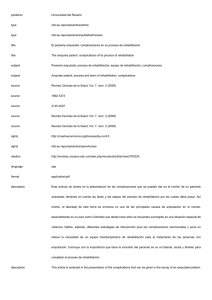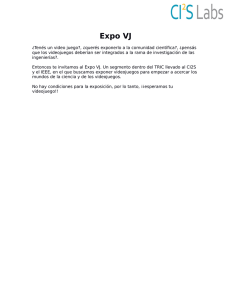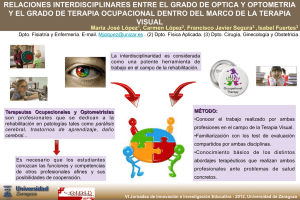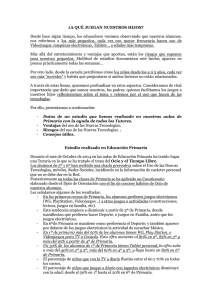Neurojuegos-Juegos-Para-La-Mente
Anuncio
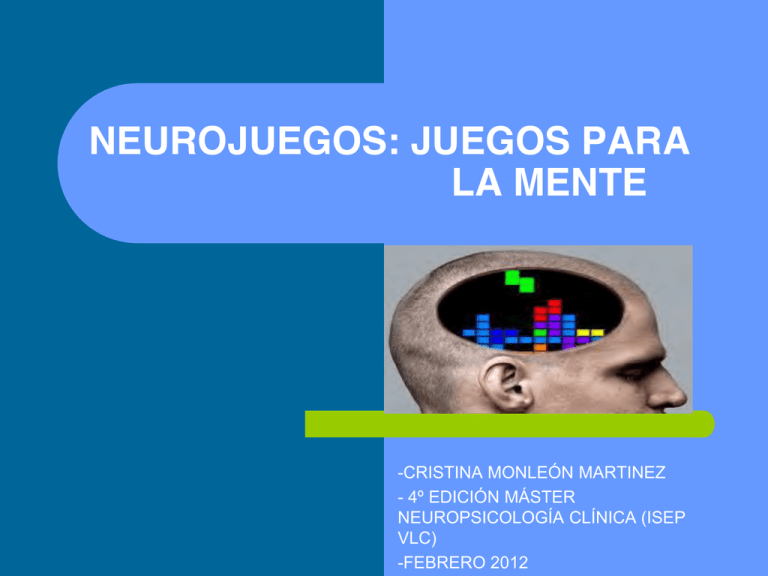
NEUROJUEGOS: JUEGOS PARA LA MENTE -CRISTINA MONLEÓN MARTINEZ - 4º EDICIÓN MÁSTER NEUROPSICOLOGÍA CLÍNICA (ISEP VLC) -FEBRERO 2012 INDICE 1. Historia y evolución 2. Introducción a los neurojuegos 3. Fundamentos a) Efectos en la actividad y volumen cerebral b) Videojuegos y Dependencia c) Efectos secundarios 4. Aplicaciones de los neurojuegos a) LabHuman b) Accidente cerebrovascular (ACV) c) Traumatismo craneoencefálico (TCE) 5. Otras aplicaciones tecnológicas 6. Conclusiones 7. Bibliografía 1. HISTORIA Y EVOLUCIÓN Años 70: aparecieron los programas pioneros como terapia recreativa. Años 80: el uso de los primeros ordenadores personales y software educativos. A mediados de los 80: los médicos de diversos ámbitos empezaron a producir y comercializar software especialmente escrito para la rehabilitación cognitiva. 1. HISTORIA Y EVOLUCIÓN El software del ―Computer -assisted cognitive retraining‖ (CARC) deriva de 3 fuentes: 1) Los videojuegos 2) Software educativo 3) Programas de rehabilitación cognitiva 1. HISTORIA Y EVOLUCIÓN LOS VIDEOJUEGOS Lynch (1982) fue el primero en describir el uso de los videojuegos como rehabilitación cognitiva. * Investigación inicial. Los videojuegos Pong, Breakout, Pac-Man y Space Invaders se usaban para pacientes que tenían problemas de atención, concentración, exploración visual y procesamiento simultáneo. 1. HISTORIA Y EVOLUCIÓN LOS VIDEOJUEGOS Drew y Waters (1986) Método: grupo con edades comprendidas entre los 61-78 años. formación 2 veces/ semana durante 1 hora. evaluación Wais, Purdue y test de persecución rotatoria. Resultados: encontraron mejoras en las puntuaciones de los videojuegos y en las puntuaciones de los tests a diferencia de los sujetos controles. Limitaciones de las investigaciones: -Problemas de generalización. -Validez ecológica -Falta de transferencia a las AVD. 1. HISTORIA Y EVOLUCIÓN SOFTWARE EDUCATIVO A principios el software era bastante primitivo para los estándares actuales. Con las mejoras en el hardware aparecieron los monitores en color, gráficos más sofisticados, mayor capacidad de almacenamiento y dispositivos de entrada alternativos. Ventajas Inconvenientes Buena programación Nivel de dificultad Bajo coste Puntuación compleja Transiciones fáciles Ausencia de variables importantes 1. HISTORIA Y EVOLUCIÓN PROGRAMAS REHABILITACIÓN COGNITIVA Fueron desarrollados a finales del 70 y principios de los 80. Contenidos iniciales: memoria, habilidades perceptivo-motoras y resolución de problemas. Y más tarde en AVD. Los programas van mejorando y son más elaborados, flexibles y relevantes para los problemas de los pacientes con deterioro cognitivo. ¿ES CACR EFICAZ? Puede ser eficaz en remediar ciertas deficiencias cognitivas 1. HISTORIA Y EVOLUCIÓN TENDENCIAS ACTUALES Actualmente los neurojuegos se centran mayoritariamente en la recuperación motora de las actividades de la vida diaria (AVD) en pacientes con ictus o traumatismos craneoencefálicos. Los sistemas más utilizados son: -Nintendo Wii ® -Playstation Eyetoy ® -Realidad Virtual (RV) -Realidad Aumentada (RA) 2. INTRODUCCIÓN A LOS NEUROJUEGOS Relación videojuego-cognición Un videojuego implica diferentes habilidades cognitivas (Lindley y Sennersten, 2006) : -gestión de los mecanismos de interacción -familiarizarse con la semántica de la interacción -adquirir la experiencia de juego Variables importantes: -la toma de decisiones -memoria de la experiencia previa -la motivación 2. INTRODUCCIÓN A LOS NEUROJUEGOS Clasificación realidad virtual: INMERSIVOS NO INMERSIVOS Interacción mediante algún tipo de hardware (guante de datos, cascos visualización estereoscópica, pantallas). Interacción mediante un teclado, mando o ratón sin necesidad de otro tipo de hardware. Alto coste Bajo Coste Poco accesibles. Más accesibles y aceptados por los usuarios. 2. INTRODUCCIÓN A LOS NEUROJUEGOS Sistemas inmersivos: 2. INTRODUCCIÓN A LOS NEUROJUEGOS Sistemas no inmersivos: Nintendo Wii eBaViR (Balance de Rehabilitación Virtual fácil), un sistema basado en la Nintendo ® Wii Balance Board ® (WBB), para mejorar el equilibrio. Nintendo Wii Sports Playstation Eyetoy 2. INTRODUCCIÓN A LOS NEUROJUEGOS Realidad Virtual VS Realidad Aumentada -RV sumerge completamente al usuario dentro de un entorno artificial. Mientras se está inmerso, el usuario no puede ver el mundo real que nos rodea. -RA permite al usuario ver el mundo real, con objetos virtuales superpuestos o mezclados con el mundo real. 3. FUNDAMENTOS A) EFECTOS EN LA ACTIVIDAD Y VOLUMEN CEREBRAL Nature 423, 534 - 537 (29 May 2003) Action video game modifies visual selective attention C. SHAWN GREEN AND DAPHNE BAVELIER As video-game playing has become a ubiquitous activity in today's society, it is worth considering its potential consequences on perceptual and motor skills. It is well known that exposing an organism to an altered visual environment often results in modification of the visual system of the organism. The field of perceptual learning provides many examples of training-induced increases in performance. But perceptual learning, when it occurs, tends to be specific to the trained task; that is, generalization to new tasks is rarely found. Here we show, by contrast, that action-video-game playing is capable of altering a range of visual skills. Four experiments establish changes in different aspects of visual attention in habitual video-game players as compared with non-video-game players. In a fifth experiment, non-players trained on an action video game show marked improvement from their pre-training abilities, thereby establishing the role of playing in this effect. Resultados: Los jugadores de videojuegos poseen una mayor capacidad de la atención que los no jugadores. 3. FUNDAMENTOS A) EFECTOS EN LA ACTIVIDAD Y VOLUMEN CEREBRAL Los jugadores VS los no jugadores: Superan a sus pares en el seguimiento de tareas, donde los participantes deben rastrear muchos objetos en movimiento de forma independiente, por lo tanto, mostrando un aumento de la capacidad de la atención. (Green & Bavelier, 2006). También se desempeñan mejor en el campo de visión útil de trabajo (distribución espacial de la atención), en donde los participantes deben localizar un objetivo rápidamente entre una gran cantidad de objetos que distraen (Green & Bavelier,2006). Además pueden resolver los detalles visuales en el contexto de distractores apretados, como en la tarea de hacinamiento. En esta tarea, que flanquean los objetos por encima y por debajo de un objetivo central afecta negativamente a la capacidad de identificar el objetivo central. De este modo, los participantes muestran un mayor procesamiento visual (Green & Bavelier, 2007). Demuestran una mayor capacidad de rotación mental. 3. FUNDAMENTOS A) EFECTOS EN LA ACTIVIDAD Y VOLUMEN CEREBRAL Método: -36 chicas (12-15 años) -15 grupo tetris y 11 grupo control -entrenamiento 1h 30m por semana (durante 3 meses) Resultados: 3. FUNDAMENTOS A) EFECTOS EN LA ACTIVIDAD Y VOLUMEN CEREBRAL Método: -12 sujetos: 6 niños (3 niños y 3 niñas) y 6 adultos: 3 mujeres y 3 hombres) -15 s tarea y 15 s relajación (Donkey Kong) Resultados: -En los adultos aumentó significativamente el total de las concentraciones de Hb prefrontal, mientras que en los niños disminuyó. -Estos cambios pueden ser debidos por: el rendimiento del juego de un sujeto, los niveles de atención y el interés, las respuestas fisiológicas, o de la edad de los diferentes circuitos neuronales. 3. FUNDAMENTOS A) EFECTOS EN LA ACTIVIDAD Y VOLUMEN CEREBRAL Conference of the IEEE EMBS Lyon, France August (2007) Método: A High Resolution EEG Study of -2 sujetos sanos Dynamic Brain Activity during -jugar videojuego durante 65 minutos (Mario Power Tenis) Video Game Play SHEiKHOLESLAMI, YUAN, HE, BAI, YANG AND FELLOW Resultados: -incremento en la actividad theta en el lóbulo frontal -Incremento de ondas alfa en el lóbulo parietal A high resolution EEG study was conducted on Healthy human subjects during video game play. Throughoutthe game playing experiment short time segments ofspntaneous activity were recorded. Spectral analysis was performed on these segments for the theta-wave (4-8 Hz) and alpha wave (8-13 Hz) bands to investigate the modulatory effects of long-lasting game play andthe dynamic changes of spectral contribution in range of alpha and theta-wave. The present results revealed that a) the frontal midline theta-wave activity increased over time relative to the eye open resting condition and b) the parietal alpha-wave activity Initially decreased relative to the resting condition, then followed by a slow increase. These experimental results indicate the high resolution EEG provides a useful quantitative analysis tool for studying dynamic brain activity 3. FUNDAMENTOS A) EFECTOS EN LA ACTIVIDAD Y VOLUMEN CEREBRAL Método: -20 adultos mayores (62-75 años) -entrenamiento 1h 30 min. durante 6 semanas (Rise of Nations) Resultados: -Áreas en las que se produjo una mejora en el tiempo: -corteza prefrontal medial -volumen de materia gris del PCG, o área somatosensorial. -Volumen de la CAC ventral derecha -el córtex prefrontal dorsolateral -cerebelo 3. FUNDAMENTOS A) EFECTOS EN LA ACTIVIDAD Y VOLUMEN CEREBRAL -Áreas en las que se produjo una mejora en la velocidad: -circunvolución precentral izquierda y derecha -cortex premotor izquierdo 3. FUNDAMENTOS A) EFECTOS EN LA ACTIVIDAD Y VOLUMEN CEREBRAL Método: -42 sujetos (18-28 años) -entrenamiento de 20 horas: 10 sesiones de 2 horas (Space Fortress) - Resultados: volumen del cuerpo estriado dorsal mayor rendimiento 3. FUNDAMENTOS B) VIDEOJUEGOS Y DEPENDENCIA Diferentes estudios apuntan que los jugadores de videojuegos tienen una actividad similar a la de personas con dependencia de sustancias. Método: -21 estudiantes (14 hombres y 7 mujeres de 20-30 años) -60 minutos por día durante 6 semanas. Resultados: la actividad cerebral fue mayor en la corteza cingulada anterior y la corteza orbitofrontal de los sujetos con el juego excesivo juego en Internet . 3. FUNDAMENTOS B) VIDEOJUEGOS Y DEPENDENCIA Método: -19 sujetos hombres (18-23 años) - 60 minutos por día durante 10 días. (War Rock) - 2 grupos (MIGP y GP) - Evaluación actividad cerebral MRI y el deseo de jugar. Resultados -La actividad cerebral es similar a la observada en las personas con dependencia de sustancias o el juego patológico. -En particular, las señales parecen provocar normalmente la actividad en la corteza prefrontal dorsolateral, orbitofrontal, circunvolución del hipocampo y el tálamo. 3. FUNDAMENTOS B) VIDEOJUEGOS Y DEPENDENCIA 3. FUNDAMENTOS C) EFECTOS SECUNDARIOS Wii número creciente de casos han sido informados en la literatura desde junio de 2007 (graves lesiones osteoarticulares en hombro o rodilla y hemotórax) 1º CASO Mujer 47 años disección proximal de la ACI por la intensa práctica (3 horas) de un videojuego de deporte Wii ®. Consecuencias: hemiplejía derecha y afasia 2º CASO Niño 14 años disección de la ACI después de 2 períodos consecutivos de sesiones de 3 horas. Consecuencias: hemiparesia izquierda. 3. FUNDAMENTOS C) EFECTOS SECUNDARIOS Realidad Virtual Cybersickness: enfermedad de movimiento que experimentan los usuarios que utilizan R.V. Sensación de movimiento libre (convección). Síntomas principales: - Nauseas - Fatiga ocular - Mareos - Dolor de cabeza - Desorientación - Ataxia Causa es desconocida, pero existen 3 teorías principales: -Teoría del conflicto sensorial -Teoría del veneno -Teoría de la inestabilidad postural 3. FUNDAMENTOS C) EFECTOS SECUNDARIOS Otros factores que influyen: 1) Factores tecnológicos -Posición de seguimiento de errores -Retraso -Parpadeo 2) Factores individuales -Género -Edad -Enfermedad -Posición en el simulador 4. APLICACIONES DE LOS NEUROJUEGOS A) LABHUMAN LabHuman (Laboratorio de Tecnologías Centradas en el Humano). Destacan diversos proyectos: Eco-train motor sistema virtual para la rehabilitación motora de pacientes con daño cerebral. Vircog orientado a la rehabilitación cognitiva de pacientes con trastornos neuro-psicológicos y negligencia unilateral espacial. 4. APLICACIONES DE LOS NEUROJUEGOS A) LABHUMAN Eldergames proyecto para desarrollar un sistema para enriquecer la calidad de vida de las personas mayores realizada a través de los videojuegos. ETI sistema de terapia inteligente con tres aplicaciones principales: -Aplicación del terapeuta -Aplicación en casa del paciente -Aplicación móvil. BioTrak herramienta de rehabilitación integral motora y cognitiva basado en tecnologías virtuales. 4. APLICACIONES DE LOS NEUROJUEGOS a) Accidente cerebrovascular Método: -sujeto de 60 años (lesión HD) -entrenado durante un periodo de 4 semanas ( 12 sesiones de 90 minutos) Resultados: - destreza de los dedos, fuerza de agarre y resistencia. tiempo para completar el ejercicio 4. APLICACIONES DE LOS NEUROJUEGOS a) Accidente cerebrovascular Método: -8 sujetos: 6 hombres y 2 mujeres, rango de edad 50 a 81. (7 lesión HD y 1 HI) -entrenamiento 2 a 2h 30 min. / día, 5 días / semana, por un total de casi 3 semanas. Resultados: - Mejoría en rango de movimiento, velocidad, fraccionamiento, y fuerza. 4. APLICACIONES DE LOS NEUROJUEGOS a) Accidente cerebrovascular Método: - 5 sujetos con hemiparesia por ACV. - 3 veces por semana durante 45 minutos durante 5 semanas. Resultados: - Mejoró la velocidad en todos los pacientes, pero solo en 2 pacientes la variable tiempo. The American Society of Neurorehabilitation 2007 Assessment and Training in a 3 Dimensional Virtual Environment With Haptics: A Report on 5 Cases of Motor Rehabilitation in the Chronic Stage After Stroke BROEREN,J., RYDMARK,M., BJÖRKDAHL,A. and STIBRANT, K. Objective. This exploratory study assessed the possible Effectiveness of hemiparetic upper extremity training in Subjects with chronic stroke with computer instrumentation (haptic force feedback) and 3-dimensional Visualization applied to computer games, as well as to evaluate concurrent computerassisted assessment of the kinematics of movements and test whether any improvement detected in the computer Environment was reflected in activities of daily living (ADLs). Methods. A single-subject repeated-measures experimental design (AB) was used. After Baseline testing, 5 patients were assigned to the therapy 3 times a week for 45 min for 5 weeks. Velocity, time needed to reach, and hand path ratio (reflecting superfluous movements) were the outcome measures, along with the Assessment of Motor and Process Skills and the Box and Block test. The follow-up phase (C) occurred 12 weeks later. Results. Improvements were noted in velocity, time, and hand path ratio. One patient showed improvement in occupational performance in ADLs. Conclusions. The application of this strategy of using virtual reality (VR) Technologies may be useful in assessing and training stroke patients. The results of this stud must be reproduced in further studies. The VR systems can be placed in homes or other nonclinical settings. 4. APLICACIONES DE LOS NEUROJUEGOS a) Accidente cerebrovascular Método: - 6 sujetos con ACV - 45 minutos por día (5 días por semana) durante un máximo de 5 semanas. - Utilizan RV, ejercicios de golpear, capturar y ―gra sping‖. Resultados: - Mejora en los resultados de los tests neuropsicológicos. 4. APLICACIONES DE LOS NEUROJUEGOS a) Accidente cerebrovascular Método: -17 participantes se asignó al azar a rehabilitación con RV o terapia estándar. - período de 3 semanas (9 sesiones de 1 hora de duración) - tareas de agarrar, pellizcar y el movimiento bruto Resultados: -No hay diferencias significativas entre los grupos, y después de la intervención hay mejoría en ambos. 4. APLICACIONES DE LOS NEUROJUEGOS a) Accidente cerebrovascular Método: -29 sujetos con ACV:17 mujeres y 12 hombres (edades entre 44-85 años) -dividieron en 2 grupos: • 13 sujetos rehabilitación hospitalaria y • 16 sujetos a rehabilitación en un centro para la comunidad (ictus Foro) -Tarea consistía en señalar con un lápiz táctil los números 1 habiendo otros números como distractores. Resultados: - Aumento en la velocidad y disminución del tiempo. 4. APLICACIONES DE LOS NEUROJUEGOS a) Accidente cerebrovascular Estudio 1: Playstation Eyetoy VS IREX Estudio 2: Adultos jóvenes VS adultos Mayores Estudio 3: ACV agudo VS ACV crónico 4. APLICACIONES DE LOS NEUROJUEGOS a) Accidente cerebrovascular Método: -41 sujetos ( 21 hemiparéticos y 20 de control) - Videojuego Spheroids consiste en interceptar las esferas que se mueven hacia el usuario. -Se ajusta al nivel del usuario. Resultados: -En resumen, el brazo no parético de los pacientes mostró propiedades similares a los brazos de control grupo, a pesar de ser más lento en el rendimiento de la tarea. -Por otro lado, el brazo paralizado, fue notablemente diferente del grupo control y también de la contralateral no parético brazo 4. APLICACIONES DE LOS NEUROJUEGOS b) Traumatismo craneoencefálico Método: -Joven de 24 años con TBI por accidente de coche (amnesia anterógrada severa y amnesia retrograda y déficit en el aprendizaje espacial). -Entrenamiento: 1h 30m, 3 veces a la semana durante 5 semanas. Resultados: - Mejor rendimiento en las pruebas neuropsicológicas. -Mejora de la memoria, funciones ejecutivas y de atención. 4. APLICACIONES DE LOS NEUROJUEGOS b) Traumatismo craneoencefálico Método: -13 sujetos con TBI -Tarea de interceptar las burbujas (Octopus) Resultados: -Mejoraron en el rendimiento del juego, el movimiento del brazo tiempo y precisión. 5. OTRAS APLICACIONES TECNOLÓGICAS ROBÓTICA Método: -8 sujetos con ACV -3 sesiones de entrenamiento de 1 hora semanal, por un total de 560 repeticiones por sesión. (anklebot) Resultados: -Mejora del control de motor parético tobillo, movimientos más rápidos y suaves. Y aumento de la velocidad al andar. 5. OTRAS APLICACIONES TECNOLÓGICAS Método: -7 sujetos con ACV -2 sesiones de entrenamiento de 1 hora semanal, por un total de 560 repeticiones por sesión. (anklebot) Resultados: -Mejora la velocidad de movimiento, la suavidad, y la precisión. 6. CONCLUSIONES Los neurojuegos parecen ser una herramienta eficaz para la rehabilitación motora y cognitiva, ya que pueden inducir fenómenos de plasticidad y reorganización cortical. Mejoras en habilidades motoras como: fuerza, movimiento, equilibrio y velocidad. Mejoras en habilidades cognitivas como: memoria, funciones ejecutivas y atención. Aumentan la motivación del paciente Además la accesibilidad y el bajo coste de las consolas comerciales son las principales ventajas de una tecnología que, inicialmente desarrollada para el ocio, puede ser utilizada por el paciente para realizar ejercicios en el domicilio que optimicen su recuperación funcional. 7. BIBLIOGRAFÍA 1. Adamovich, S.V., Merians, A.S., Boian, R., Lewis, J.A., Tremaine, M., Burdea, G.S., Recce, M., Poizner, H. (2005). A Virtual Reality–Based Exercise System for Hand RehabilitationPost-Stroke. Presence, Vol. 14, No. 2: 161–174. 2. Alcañiz M., Ortega M., Pérez D., Rey B., Calvo G. (2008). HUM-AR: An augmented reality system specially adapted for education. INTED 2008, International technology, education and development conference. 3. Basak, C., Voss, M. W., Boot, W. R., Erickson, K.I, & Kramer, A. F. (2011). Regional differences in brain volume predict the acquisition of skill in a complex real time strategy videogame, Brain and Cognition, 76: 407–414. 4. Bayón, M. y Martínez, J. (2009). Rehabilitación del ictus mediante realidad virtual. Rehabilitación, 44(3): 256-260. 5. Broeren, J. et all. (2008). Virtual Rehabilitation after Stroke. IOS Press. 6. Broeren, J, Rydmark M, Björkdahl A, Sunnerhagen K.S. (2007). Assessment and training in a 3dimensional virtual environment with haptics: a report on 5 cases of motor rehabilitation in the chronic stage after stroke. Neurorehabil Neural Repair , 21:180–189. 7. Broeren, J, Rydmark M, Sunnerhagen K.S. (2004). Virtual reality and haptics as a training device for movement rehabilitation after stroke: A single-case study. Arch Phys Med Rehabil , Vol 85. 7. BIBLIOGRAFÍA 8. Caglio, M., Latini-Corazzini, L., D’agata, F., Cauda, F., Sacco, K., Monteverdi, S., Zettin, M., Duca, S., Geminiani, G. (2009). Video game play changes spatial and verbal memory: rehabilitation of a single case with traumatic brain injury. Cogn Process,10 (Suppl 2):S195–S197. 9. Cameirão, M., Bermúdez , S., Duarte Oller, S., Verschure, P. (2010). Neurorehabilitation using the virtual reality based Rehabilitation Gaming System: methodology, design, psychometrics, usability and validation. Journal of NeuroEngineering and Rehabilitation, 7:48. 10. Crosbie, J.H., Lennon, S., McGoldrick, M.C., McNeill, M.D.J., Burke, J.W., and McDonough, S.M. (2007). Virtual reality in the rehabilitation of the upper limb after hemiplegic stroke: a randomised pilot study. ICDVRAT/University of Reading, UK; ISBN 07 049 15 00 6. 11. Eng, K., Siekierka, E., Pyk, P., Chevrier, E., Hauser, Y., Cameirao, M., Holper, L., Hägni, K., Zimmerli, L., Duff, A., Schuster, C., Bassetti, C., Verschure, P., Kiper, D. (2007). Interactive visuomotor therapy system for stroke rehabilitation. Med Bio Eng Comput, 45:901–907. 12. Erickson, K.I., Boot, W.E., Basak, C., Neider,M.B., Prakash, R.S., Voss, M.W., Graybiel, A.M., Simons, D.J., Fabiani,M., Gratton,G. and Kramer, A.F. (2010). Striatal volume predicts level of video game skill acquisition. Cerebral Cortex, 20: 2522-2530. 13. Faivre, A., Chapon, F., Combaz, X., Nicoli, F. (2009). Internal carotid Aartery dissection occurring during intensive practice with WII® video sports games. Neurology, 73. 14. Forrester, L.W., Roy, A., Krebs, H.I., and Macko, R.F. (2010). Ankle training with a robotic device improves hemiparetic gait after a stroke. Neurorehabilitation and Neural Repair, 7. BIBLIOGRAFÍA 15. Gamberini, L., Barresi, G., Majer, A. and Scarpetta, F. (2008). A game a day keeps the doctor away: a short review of computer games in mental healthcare. Journal of CyberTherapy & Rehabilitation, Volume 1 , Issue 2. 16. Gamberini, L., Martino, F., Seraglia, B., Spagnolli, A., Fabergat, M., Ibañez, F., Alcañiz, M., Lozano, J.A., Montesa, J. (2009). Eldergames Project: an innovative mixed reality table-top solution to preserves cognitive functions in elderly people. Conference on Human System Interactions. 17. Gil, J.A., Alcañiz, M., Lozano, J.A., Montesa, J., Chirivella, J., Ferri, J., Colomer, C., Lopez, R., Revert, M., Noé, E. (2007). Eco-train motor: un nuevo sistema de rehabilitación del equilibrio en pacientes con daño cerebral. Comunicaciones posters de la Sociedad Española de Neurología. 18. Gil, J.A., Lloréns, R., Alcañiz, M. and Colomer, C. (2011). Effectiveness of a Wii balance boardbased system (eBaViR) for balance rehabilitation: a pilot randomized clinical trial in patients with acquired brain injury. Journal of NeuroEngineering and Rehabilitation, 8: 30. 19. Green, C.S. and Bavelier, D. Action video game modifies visual selective attention. Nature, Vol. 423: 534-537. 20. Green, C.S. and Bavelier, D. Exercising your brain: A review of human brain plasticity and training-induced learning. Psychol Aging, 23(4): 692–70. 21. Guixeres, J., Gomis, J., Alcañiz, M., Saiz, F.J. (2008). TIPS : Intelligent Sensory Plataform for Clinical E-Therapy. Workshop on Technology in Mental Health. 7. BIBLIOGRAFÍA 22. Han, D.H., Kim, Y.S., Lee, Y.S., Min, K.J., and Renshaw, P.F. (2010) Changes in cue-induced, prefrontal cortex activity with video-game play. Cyberpsychology, behavior, and social networking, Volume 13, Number 6. 23. Hana, D. H., Bolob, N., Daniels, M. A., Arenellac, L.,. Lyood, I.K., Renshawe,P.F. (2011) Brain activity and desire for Internet video game play. Comprehensive Psychiatry, 52 :88–95. 24. LaViola Jr. J.J. (2000). A discussion of cybersickness in virtual environments. SIGCHI Bulletin, Volume 32, Number 1: 47-55. 25. Lozano, J.A., Gil Gomez, J.A., Alcañiz Rayar, M., Chirivella, J., Ferri, J., Noé, E. & Colomer, C. (2008). VIRCOG: Virtual reality system for cognitive rehabilitation of patients with neuropsychological disorders. Brain Injury, ISSN: 02-69-9052 26. Lynch, B. (2002). Historical review of computer-assisted cognitive retraining. Journal of head trauma rehabilitation,17(5):446–457. 27. Nagamitsu, S., Nagano, M., Yamashita, Y., Takashima, S., Matsuishi, T. (2006). Prefrontal cerebral blood volume patterns while playing video games—A near-infrared spectroscopy study. Brain & Development, 28: 315–321. 28. Perry, J.C., Andureu,J., Cavallaro, F.I., Veneman, J., Carmien, S., Keller, T. (2009). Effective game use in neurorehabilitation: usercentered perspectives. 29. Rand, D., Kizony, R. and Weiss, P.L. (2008). The Sony PlayStation II EyeToy: low-cost virtual reality for use in rehabilitation. JNPT , Volume 32: 155-163. 7. BIBLIOGRAFÍA 30. Rizzo, A.A., Schultheis, M., Kerns, K.A. and Mateer, C. (2004). Analysis of assets for virtual reality applications in neuropsychology, Neuropsychological rehabilitation, 14 (1/2), 207–239 31. Roy, A., Forrester, L.W. and Macko, R.F. (2011). Short-term ankle motor performance with ankle robotics training in chronic hemiparetic stroke. Journal of Rehabilitation Research & Development, volume 48, number 4: 417-430. 32. Sheikholeslami,C., Yuan,H., He, E.J., Bai, X., Yang,L. and He,B. (2007). A high resolution EEG study of dynamic brain activity during video game play. Conference of the IEEE EMBS, Cité Internationale, Lyon, France. 33. Ustinova, K.I., Leonard, W.A., Cassavaugh, N.C and Ingersoll, C.D. (2011). Development of a 3D immersive videogame to improve arm-postural coordination in patients with TBI. Journal of NeuroEngineering and Rehabilitation, 8:61.

